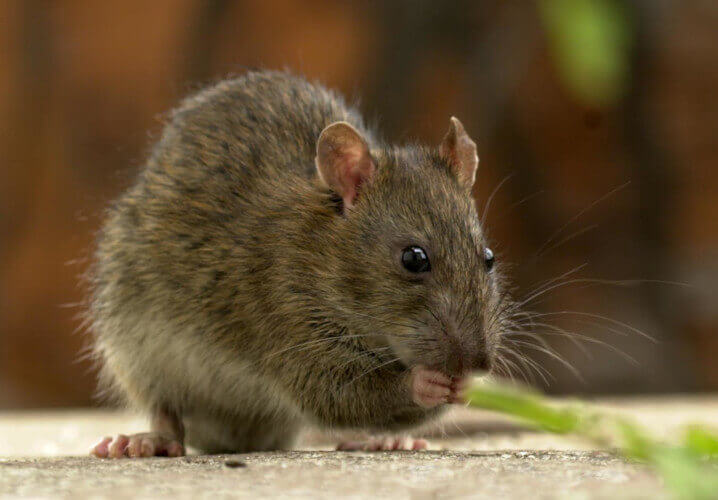Invasive Rats and Their Influence on Reef Fish

As you read this title you may have wondered what invasive rats have to do with reef fish, as they’re species that occupy very different biomes. Well, ecosystems have delicate balances that a single factor, such as a species introduced by man, can break in a matter of years.
This is one of the latest documented cases – yet more proof that we are endangering the planet. Until now, the connection between the trophic chains of an ecosystem and the consequences at the ecological level hadn’t been so thoroughly explored. Let’s take a closer look.
Tropical islands and the delicate balance of reefs
Coral reefs are both a refuge for an incredible diversity of life and a fundamental pillar of this type of ecosystem. However, all the elements that coexist in it, living or not, play an indispensable role in its balance, without which the whole biome is degraded.
Our species, sometimes innocently and sometimes not so much, affects the ecosystems with its activity, generating negative consequences such as the loss of nutrients in the environment. These nutrients have a pathway that, if interrupted, affects all species and modifies their habits and behavior.
Since the interaction between so many elements is so complex, it’s often impossible to foresee the impact of human actions, or at least those that are unintentional. The example of invasive rats has clarified one of the least studied processes in this regard, the pathway of nutrients in an ecosystem and the role it plays in its biodiversity. Let’s take a look.
The study that linked invasive rats and reef fish
In 2023 a study was published in the journal Nature Ecology & Evolution that explores how black rats (Rattus rattus) are affecting the territoriality behavior of marine vertebrates. This work was carried out by making a comparison of observations from 5 different tropical islands in the Indian Ocean, each with a different concentration of black rats.
Birds and rats
Black rats arrived as stowaways on ships traveling from Europe in the 18th century. Since then, these rodents have carved a niche for themselves in the ecosystem thanks to their great ability to adapt to new environments. However, their impact hasn’t gone unnoticed, especially for the birds of tropical islands, as this rat joined their list of predators.
Through this predation and the consumption of their eggs, the density of seabirds has been reduced. And, as the study itself states, “Seabirds are globally important contributors to nutrient transfer, responsible for a cascade of nutrients through terrestrial and marine ecosystems by depositing droppings on islands after feeding in the open sea.”
The black rat, as an introduced species, acts as a disruptive agent in this nutrient pathway.
Bird droppings and reef fish
The nutrients present in seabird droppings enrich the marine environment, making more nitrogen available in algae and fish, favoring coral growth and, as a final result, increasing the biomass of marine vertebrates. Therefore, if the number of seabirds is reduced, the biological value of these ecosystems decreases.
And this is where we come to the yellowtail damselfish (Microspathodon chrysurus), a regular consumer of the patches of algae present on the reefs. Normally, they defend it tooth and nail against other marine animals with agonistic and territorial behaviors. However, this is no longer the case on islands with a high infestation of rats. Why is this so? Let’s take a look.
The indirect impact of invasive rats on the reef

The lead researchers of the study noticed this relationship between the rats and the changing behavior of the damselfish. By measuring the quality of the surrounding waters of islands with large Rattus rattus populations, they found that there was 251 times less nitrogen than in those that were free of the infestation.
This meant that the nutritional value of the algal fields on which the damselfish feed dropped dramatically. Therefore, the number of nutrients obtained by this animal per unit effort was so low that territoriality and aggression behaviors became less and less frequent.
In other words: why defend something that isn’t worth defending?
On the other hand, the territories of the damselfish were much larger, indicating that they were prioritizing foraging over territory defense. From this we conclude that the disruption of nutrient flow affects the behavior of the animals present in the environment, leading, in turn, to a progressive degradation of the environment itself.
Could you have imagined that there was this connection between invasive rats and tropical reefs? Measuring and minimizing the impact our species has on the planet is the key to conserving what is left of it.
All cited sources were thoroughly reviewed by our team to ensure their quality, reliability, currency, and validity. The bibliography of this article was considered reliable and of academic or scientific accuracy.
- Rattus rattus (house rat). (s. f.). Animal Diversity Web. https://animaldiversity.org/accounts/Rattus_rattus/
- Gunn, R. L., Benkwitt, C. E., Graham, N. A., Hartley, I. R., Algar, A. C., & Keith, S. A. (2023). Terrestrial invasive species alter marine vertebrate behaviour. Nature Ecology & Evolution, 1-10.
- Rocha, L.A. & Myers, R. 2015. Microspathodon chrysurus. The IUCN Red List of Threatened Species 2015: e.T188617A1902927. https://dx.doi.org/10.2305/IUCN.UK.2015-4.RLTS.T188617A1902927.en. Accessed on 30 January 2023.
This text is provided for informational purposes only and does not replace consultation with a professional. If in doubt, consult your specialist.